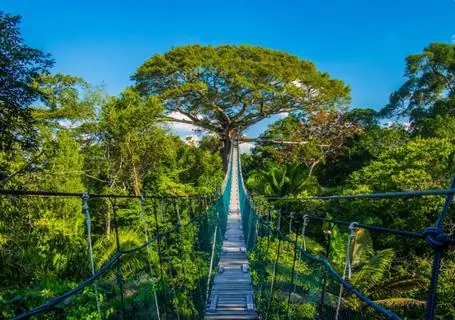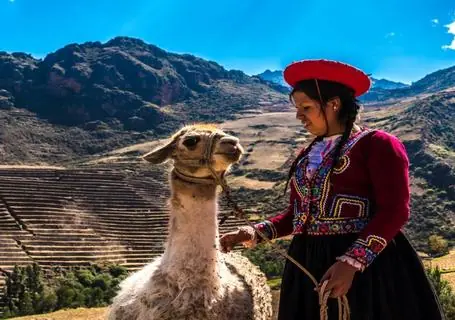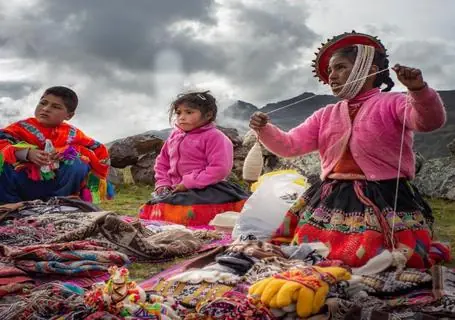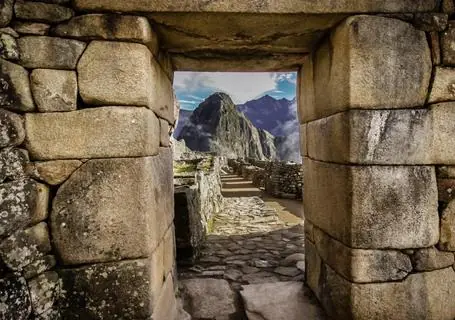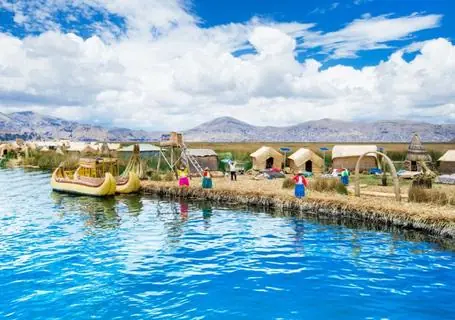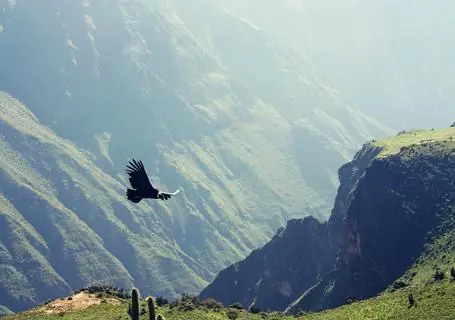Colors of Peru - 14 Days






 View All PhotosView All Photos
View All PhotosView All PhotosCultural
Easy
Arequipa, Colca Canyon, Cusco, Lake Titicaca, Lima, Machu Picchu, Puno
Archaeological / Architecture, Cooking class, Nature
cardinfo-price-per-adult
| cardinfo-text-5 | ||
| cardinfo-text-7 | Not included | |
| cardinfo-text-8 | cardinfo-not-included | |
cardinfo-text-10
h2-title-1
Our Colors of Peru tour calls to you with all the allure of the ancient and the mysterious. From the soaring peaks of the Andes to the lush Amazon Rainforest, from the pre-Colombian ruins in the mountains to the Spanish colonial mansions on the coast. This 14 Days in Peru tour offers you exciting adventures and unique experiences. Delight in every minute of your Peru vacation package and experience authentic Peru.
 Free Brochure
Free BrochureReady to explore? Download the brochure and start planning!

Your FREE travel expert is just a click away
Or Call us now! (888) 803 8004
h2-title-2
Day 1:Welcome to Lima
From the moment you arrive in Lima to begin your 14 Day Colors of Peru Tour, our team member of Valencia Travel will be waiting for you at the Lima airport to take you in private transport, to your Lima hotel. You will then have all day to relax and enjoy the beauty of Lima and its surroundings on Lima city sightseeing and cultural tours.
- Meals: Not Included
- Transfer In: Lima Airport to Hotel (1 hour approx).
- Hotel: Jose Antonio Lima itinerary-service-hotel-extra
Day 2:Lima The City of Kings and Larco Museum
The first stop on our Lima city tour is Huaca Pucllana, a huge archaeological site in Miraflores, one of Lima’s most popular districts. Huaca Pucllana was an important ceremonial and administrative center of the Lima culture, which developed along this part of the Peruvian coast between 200 AD and 700 AD. This sacred place was built from seven staggered platforms surrounded by a plaza and large walls. It’s a very impressive site, and certainly not what you expect to find in lively Miraflores!
After this brief stop at the Huaca Pucllana, we’ll drive to the historic center of Lima, all of which is a designated UNESCO World Heritage site. We’ll go to the beautiful Plaza de Armas (Lima’s main square) which is surrounded by impressive colonial and Republican-era buildings, many of which have ornate wooden balconies. Some of Peru’s most important buildings surround the square, including the Government Palace, Lima Cathedral, the Archbishop's Palace of Lima, the Municipal Palace, the Palace of the Union, and The San Francisco Convent.
We will enjoy a tour of the San Francisco Convent. The San Francisco Convent was built in the 17th century, this stunning colonial-era convent showcases exquisite Baroque architecture. Founded in 1535 and completed in 1672, the convent features a beautifully detailed facade with twin towers. Inside, visitors can admire vaulted ceilings, ornate altars, Sevillian tile-decorated courtyards, and a library holding over 25,000 rare books. The famous catacombs, once a cemetery, contain the remains of thousands, offering a glimpse into colonial burial practices. As a UNESCO World Heritage site, the San Francisco Convent is a hub for cultural events, preserving Lima's rich historical and cultural heritage.
Next, we’ll head to the private Larco Museum, which is one of the best museums in the country. Here you can see a wide range of pre-Columbian art and artifacts, including ceramics, textiles, metalwork, and more. The museum is most famous, however, for its incredible – and quite X-rated – gallery of pre-Columbian erotic pottery. These ceramics display sexual acts between men and women, as well as homosexual acts, in at times explicit detail and in various postures.
At the end of the Larco Museum tour, we will return to your hotel.
- Meals: Breakfast
- Excursion: Lima City Tour, San Francisco Convent and Larco Museum (Private Service). 5 Hours approx.
- Entrance Fee: San Francisco Convent and Larco Museum
- Hotel: Jose Antonio Lima itinerary-service-hotel-extra
Day 3:Lima to The Amazon Rainforest (Puerto Maldonado).
After Breakfast, we will transfer from the Hotel to Cusco Airport for your flight to Puerto Maldonado. Your Amazon adventure begins when we pick you up from the airport in Puerto Maldonado. We’ll then drive for 10 minutes to our Puerto Maldonado headquarters. If you have any luggage that you won’t need during the next few days, you can safely leave it here, which will help keep the boats and cargo light.
We’ll then drive to the Tambopata River Port, entering the native community of Infierno. From here it’s a beautiful 45-minute boat ride to Posada Amazonas in the community’s primary forest reserve. On arrival at the lodge, the manager will welcome you and give you important navigation and security tips.
After you’ve had lunch and settled in, we’ll head off on a 20-minute walk from Posada Amazonas that leads to the 30-meter canopy tower. From the platforms above, you’ll have spectacular views of the vast expanse of rainforest, with the Tambopata River winding through it. You’ll also see toucans, parrots, and macaws as they fly over the jungle, with many other birds in the treetops right next to you.
Returning to the lodge, we’ll have a delicious dinner and you can watch the nightly presentation about the Infierno ecotourism project, given by a local staff member.
- Meals: All Included
- Transfer Out: Hotel - Cusco Airport (20 minutes) - Assistant in English/Spanish.
- Transfer In: Airport Pick up and transfer to Posada Amazonas Lodge.
- Excursion: Amazon Jungle Excursions (Programmed Activities).
- Lodge: Posada Amazonas. Accommodation in Superior Room with private bathroom.
Day 4:Amazon Rainforest Exploration!
Today we’ll set off to the Three Chimbadas oxbow lake. We’ll board our boat and cruise along the river for 30 minutes, followed by a beautiful 45-minute hike. Once we reach the lake, we can paddle around the lake on a catamaran, searching for the resident family of nine giant river otters! We can’t guarantee that you’ll see them, but around 60% of our visitors get to see these charming creatures. We should also see plenty of other animals, including caiman, hoatzin and horned screamers.
Afterwards we’ll take a 20-minute boat drive downriver that leads to a trail designed by the staff of the Centro Ñape. The Centro Ñape is a communal organization that produces medicines out of forest plants and administers them to patients at their little clinic. The trail leads through the various medicinal plants, and your local guide can tell you all about their properties and their various uses.
Later, we’ll head out on a night walk. Many animals are still active after dark, but they are obviously hard to see. But some creatures, like frogs, are much easier to find. And the sound of the jungle at night is quite an experience, making these nocturnal excursions very memorable.
*Please bear in mind that activities at the lodge can change depending on the weather and you can also choose the activities that you prefer from the options available.
- Meals: All Included
- Excursion: Amazon Jungle Excursions (Programmed Activities).
- Lodge: Posada Amazonas. Accommodation in Confort Room with private bath.
Day 5:Puerto Maldonado to The Sacred Valley
After breakfast, it will be time to make our return journey to Puerto Maldonado. We’ll head back to the Tambopata River Port and then continue on to the city. When we arrive in Puerto Maldonado, we’ll take you to the airport for your flight to Cusco!
After your arrival to Cusco, your cultural excursion will begin when we pick you up in Cusco and drive you out to the Chinchero. When we arrive, we’ll meet some of the locals who live in the community, which is home to some 50 families. Here, the two main activities are farming and weaving, with the men working the land while the women doing the weaving. The weaving techniques have been passed down from one woman to another for centuries, and today Chinchero produces some of the most amazing textiles in Peru. During your visit, you’ll be able to attend a talk and see a demonstration about how these textiles are made, learning all about the ancient techniques that are still used today.
One of the Quechua-speaking weavers will tell us (through our translator) about the secrets of the traditional iconography used in their designs and will show you the entire manufacturing process from the shearing of the wool to spinning and the washing of the wool with natural soap. You’ll also learn about the plants and flowers that are collected to use as dyes. You can also have a go at weaving a blanket, a poncho, a chullo hat, or one of the many other items made by the women weavers of Chinchero.
After the weaving demonstration, you’ll have the rest of the day to explore the community at your leisure, getting to know the locals and seeing what else they do to keep the community thriving. And, of course, you’ll be able to purchase the amazing high-quality textiles on offer, helping to support the community directly.
Later in the day, we’ll say our goodbyes and head to Urubamba in The Sacred Valley, where we’ll drop you off at your hotel. You will then spend the remainder of the day at leisure.
- Meals: Breakfast
- Transfer In: Cusco Airport - Sacred Valley Hotel (with stop-off in Chinchero). - Asistant English/Spanish.
- Hotel: Hotel Agustos Urubamba. Accommodation in Standard Room with private bath.
Day 6:Visit to The Huilloc Comunity and Ollantaytambo
Our day begins when we pick you up from your hotel, it’s a 1-hour drive to Huilloc.
Arriving in Huilloc, we’ll be greeted by the friendly locals, and then we’ll begin to see how they have kept their language and customs alive, most immediately evident in the colorful traditional clothes that they wear. This is a cultural immersion experience, and as such you’ll be free to interact with the locals, and choose how you spend your day. You can take part in their collective tasks, working in the fields or making clothing, or seeing how they educate their children or prepare their ancestral ceremonies. We’ll also have a tasty and traditional Andean lunch with one of the local families, providing another great chance to see and experience their daily life.
Huilloc is particularly well-known for its weaving traditions, passed down through the generations. This work is carried out by the women of the community (the men work the land), often with their youngest daughters or granddaughters sitting next to them, learning the ancient techniques. The textiles they produce on their looms are decorated with the same images used in Huilloc for centuries, including condors, cougars, and the local Huallata birds. Their finished weavings, meanwhile, are some of the most beautiful produced in Peru – a country known for its traditional weavers. You can see a demonstration of their weaving process, and then have a go yourself. And you can give back to the community by purchasing some of these wonderful textiles.
After spending time in Huilloc, we’ll say goodbye to the locals and head to Ollantaytambo, Ollantaytambo was the royal estate of the Inca emperor Pachacuti, who conquered the region and built the town and a ceremonial center. We’ll spend about an hour exploring these magnificent ruins, visiting the amazing Temple of the Sun and seeing massive blocks of rock that were perfectly carved and polished by master Inca stonemasons. Ollantaytambo is also a fine example of Inca agricultural construction and hydro-engineering, with a complex series of stone water fountains, channels and agricultural terraces, the latter organized by elevation to create different microclimates for crop experimentation.
We’ll see the extent of the water system when we return to the town, where fast flowing water channels built by the Incas are still in use today. Walking to the town square, we’ll have great views of the ruins above us, as well as Inca granaries and storehouses built on the sides of the surrounding mountains. Here we can also watch the daily life of Ollantaytambo, where many of the locals still wear traditional dress.
After the visit to Ollantaytambo ruins, we will head to the train station to board the train to Aguas Calientes (also known as Machu Picchu Pueblo). The train leaves at approximately 16h36, although the exact schedule does change sometimes. The two-hour train journey is a memorable experience in itself, as we pass through river canyons and rolling hills.
Aguas Calientes is the gateway to Machu Picchu, sitting in a deep gorge at the foot of the mountain upon which Machu Picchu is located. It’s a pretty town that mixes traditional life with a huge tourism infrastructure, with plenty of markets, souvenir shops, hotels and restaurants. It’s also largely pedestrianized, making it a fun place to explore on foot. Aguas Calientes is surrounded by jungle-covered mountains and cliffs, and the Urubamba River flows right next to the town, sometimes roaring through the canyon.
Aguas Calientes is named after the thermal hot springs, and when we arrive you’ll have plenty of time to relax and enjoy a dip in one of the steaming natural springs. You’ll also have time to walk around the town, exploring the colorful markets and general buzz of this unique Peruvian settlement.
It’s an early start the next day, so we’ll make sure you’re settled into your hotel and all set for the following day and your first glimpse of Machu Picchu!
- Meals: Breakfast, Lunch
- Excursion: Huilloc Community, Ollantaytambo Train Station
- Train Ticket: Ollantaytambo - Aguas Calientes Train Station
- Hotel: Hatun Inti Boutique itinerary-service-hotel-extra
Day 7:Aguas Calientes – Cusco
To best appreciate Machu Picchu, we’ll wake up early in the morning so we can get to the citadel in good time. You’ll have time for breakfast first, and then your guide will pick you up from the hotel at around 5:40 a.m. Then we will walk to the starting point of the bus, a trip of approximately 45 minutes in the direction of the citadel of Machu Picchu.
We’ll then pass through the gates to the Machu Picchu archaeological site. Here you’ll begin your guided walking tour with an experienced and highly knowledgeable guide. Our tour of Machu Picchu will last about two hours and will take you to all the most famous and spectacular parts of the extensive archaeological complex. These include the House of the Guardian, Intihuatana, Temple of the Sun, Sacred Plaza, and other key locations. (It will depend on the circuit that the Ministry of Culture determines).
And as we walk around, we’ll have spectacular views across the agricultural terraces of Machu Picchu and across to the surrounding mountains and plunging gorges.
Once we’ve finished our tour of Machu Picchu, we’ll take the bus back down to Aguas Calientes where you can relax and have lunch (not included) before we board the train back to Poroy and Cusco. Upon arrival at the station, our staff will be waiting for you to take you back to your hotel in Cusco, a quick trip of approximately 25 minutes, where you will be able to remember your incredible tour of one of the most famous and impressive attractions in the world.
- Meals: Breakfast
- Tour Guide: Local Tour Guide: English/Spanish
- Bus: Aguas Calientes - Machu Picchu - Aguas Calientes (20 minutes approx).
- Entrance Fee: Machu Picchu Citadel
- Train Ticket: Aguas Calientes To Ollantaytambo or Poroy
- Transfer: Ollantaytambo Train Station - Cusco Hotel
- Hotel: Jose Antonio Cusco itinerary-service-hotel-extra
Day 8:Cusco City Tour
Our Cusco city tour begins in the morning, when we’ll first head to the wonderful Koricancha, next door to Santo Domingo Church. According to the chroniclers who wrote during the period directly after the Spanish Conquest, the Koricancha was the most sacred and most important temple in the Inca Empire. Its walls were covered with gold, and life-size statues of plants and animals – all made of pure gold and silver – decorated its rooms and hallways. Sadly, this wealth was stripped out by the Spanish conquistadors. It remains a magnificent temple, however, and your guide will take you around the Koricancha, showing you details that you almost certainly miss if you visited without a guide.
After visiting the Koricancha, we’ll head to Cusco Cathedral, located on the Plaza de Armas. Built between 1560 and 1654 on top of the foundations of an existing Inca temple, this spectacular cathedral houses many works of art by the Cusco School of painters, and its main altar and pulpit are covered in gold and silver relief work. Look carefully and you’ll also see elements of indigenous religious symbolism incorporated into the church by the native people who worked on its construction, such as the carved head of a jaguar on the doors.
Our next stop is the imposing Inca fortress of Sacsayhuaman, which sits on a hill above Cusco. Here you will see some of the finest examples of Inca stonework and construction, including massive rocks that were carefully cut and perfectly fitted together to form the walls. From here you’ll also have beautiful panoramic views of Cusco.
After exploring Sacsayhuaman we’ll head up the hill to the Tambomachay Archeological Complex. The exact purpose of this site is unknown, but it may have functioned, at least in part, as an Inca spa. Inca hydro-engineering is apparent here, with a series of aqueducts, canals, and waterfalls running through the terraced rocks.
Tambomachay is the last attraction on our city tour, after which we’ll head back down into Cusco and drop you off at your hotel.
- Meals: Breakfast
- Excursion: Cusco City Tour - Shared Service (4 hours approx).
- Tour Guide: Local Tour Guide: English/Spanish
- Entrance Fee: Koricancha Temple and Cathedral
- Hotel: Jose Antonio Cusco itinerary-service-hotel-extra
Day 9:Cusco to Puno by train!!!
We will pick you up at 06h00 and take you to the Train station in Cusco. The route covered by the Titicaca train is considered by many travel magazines to be one of the most beautiful in the world, with a trip that lasts ten and a half hours. At the start of the journey, passengers are welcomed at the Wanchaq Station (Cusco), where local musicians will provide background music as you board the train. Once aboard, you can enjoy the two dining cars decorated in the style of the Pullman cars of the 1920s. Also, during the trip, you will have the finest in gourmet food. Once you arrive in Puno, the folklore capital, you will be taken to your hotel where you will stay the night. At night, keep to the main, lit areas. The main street will be obvious and there are lots of little restaurants there.
- Meals: Breakfast, Lunch
- Transfer Out: Cusco Hotel - Wanchaq Train Station
- Train Ticket: Titicaca Train - Cusco to Puno (Lunch Aboard).
- Transfer In: Puno Train Station- Hotel.- Assistant English/Spanish.
- Hotel: Hotel Royal Inn Puno. Accommodation in Standard Room with private bathroom.
Day 10:Uros & Taquile Islands
Our full-day trip on this Peru tour begins around 07:00 when we will pick you up from your hotel in Puno. Then we will go to the port and board our comfortable boat to go to Uros Island, followed by Taquile Island. It is Puno Tours and Lake Titicaca Trips like this one, that show you the real Peruvian way of life!
When we get to the floating islands, you will probably be surprised by the scale of these floating reed constructions. The Uros originally built these islands for defensive reasons: if a threat appeared, they could move their island homes to a safer location. The islands are made from cattail reeds that grow around the lake, and each island is in a constant state of rebuilding, as old reeds are replaced with new ones. Entering the islands is quite an experience, as the reed floor feels strange under your feet. We will explore the main island and see the houses, watchtowers, and other structures, all built from reeds. Then one of the locals will give a short presentation on how the islands are made and then you can meet one of the local families to see how they live. Next, we head to Taquile, one of the most beautiful islands in Peru, where the traditional way of life is still very much alive. We will meet some of the master weavers of this ancient Andean community, whose textiles are considered among the best in the country. According to legend, the Incas themselves learned to weave from the artisans of this island. In Taquile, the men are the weavers and the women spin the thread.
After seeing the weavers and exploring the beautiful island, we will head to the small port of Taquile around noon, where we will enjoy a delicious local menu, made with local products and if we are lucky, trout from Lake Titicaca!
Finally, we will return to Puno from our tours of the islands of Lake Titicaca in Peru, where we will take you to your hotel for the evening.
- Meals: Breakfast, Lunch
- Transfer: Puno Hotel to Puno Port
- Excursion: Visit Uros Islands and Taquile - Shared Service with private guide.
- Entrance Fee: Uros & Taquile Island
- Transfer: Puno Port - Hotel (Assistant English/Spanish).
- Hotel: Hotel Royal Inn Puno. Accommodation in Standard Room with private bathroom.
Day 11:Puno - Colca Canyon
Departure from Puno between 06h00 to 06h30, we’ll drive toward to Chivay Village. We will have a trip around 5 hours with stops on the way to take photographs. You will observe the area called "Lagunillas", where with some luck we can see South American camelids, and maybe take some pictures of flamingos, birds, and Andean ducks, Continuing on the road we will pass Tocra, a high plain at more than 4,500 meters, where we will observe lakes with migrant birds and get pictures of the Antiplano with its Llamas and Guanacos. The highest point of our tour will be Pata Pampa (Pata=high, Pampa=land) located at 4,820 meters, where we’ll observe the volcanoes Ampato, Sabancaya, Hualca-Hualca, Mismi (the source of the Amazon River), and the Cordillera de Chila.
Our next stop will be the town of Chivay, where one end of the Colca Valley begins. The traditional terrace systems found here, built by indigenous inhabitants of the area, are remarkable for their scale and precise construction. Chivay itself was founded by the Spanish, a fact reflected in its church and other colonial buildings. You can have a traditional lunch in the town (not included) before we check in to our hotel.
You’ll then have the afternoon to explore the town on your own, and, if you like, visit the hot springs at La Calera, about 3 km from Chivay (Not Included). Colca Canyon and the Colca Valley are dotted with natural hot springs and thermal baths, thanks to the seismic activity in the region. La Calera has public thermal baths which are said to have healing properties, with temperatures around 38 C (98 F).
- Meals: Breakfast
- Excursion: Puno to Colca - Shared Service.
- Tour Guide: Local Tour Guide: English/Spanish
Day 12:Colca Canyon – Arequipa
It’s another early start today because there’s so much great stuff to see! First we’ll go to the lookout point known as Cruz del Condor (Cross of the Condor), near the small villages of Maca and Cabanaconde. Here, strong winds rise up from the canyon, providing a favorite spot for Andean condors. They soar on the thermals, often in pairs, normally in the early morning and late afternoon. There’s a good chance you’ll see these huge condors, with their three-meter wingspans, flying very close to the lookout point, providing a truly majestic sight. From the lookout point, you’ll also have incredible views down into the depths of Colca Canyon.
We’ll then head back to Chivay, first stopping off at the traditional village of Pinchollo and the Antahuilque viewpoint. This viewpoint (or Mirador, as they are known in Spanish) offers wonderful views of the 1,500-year-old agricultural terraces that curve along the hillsides like an amphitheater. You can also spot some of the enchanting lagoons of the Colca Valley. We will have lunch in Chivay (not included) in the afternoon and then begin the journey to Arequipa (4 hours).
- Meals: Breakfast
- Excursion: Colca Canyon Visit and Condor Cross - Arequipa Hotel
- Tour Guide: Local Tour Guide: English/Spanish
- Hotel: Hotel Casa Andina Standard Arequipa. Accommodation in Standard Room with private bathroom.
Day 13:Arequipa to Lima
After Breakfast, we will visit the convent of Santa Catalina, you have the opportunity to walk around the white city and its surroundings. The architecture in the historic center is characterized by the prominence of ashlar, the use of which begins in the last third of the s. XVI. This volcanic stone, white or pink exceptionally soft, lightweight, and weatherproof, emerged as a seismic structural solution.
Arequipa Gastronomic Experience:
Our gastronomic tour begins at 10 a.m. First, we head to the local San Camilo market, located not far from Arequipa’s Plaza de Armas. San Camilo is a very popular traditional Peruvian market, and arguably the most authentic and most interesting in Arequipa. The lively market is packed with butchers, spices merchants, fruit and veg stalls, souvenir sellers, and more, as well as food courts selling a wide range of classic local snacks and dishes. It’s a heady mix of color and sound, as well as plenty of smells – so get ready to hold your nose, as it can become quite pungent, a certain sign of a truly authentic local market!
We’ll explore the market and buy all of the fresh ingredients we’ll need to prepare two dishes: an entrée and a main dish. Then we’ll go to a local family home and start cooking! You’ll be given all the necessary instructions by a highly knowledgeable local cook, who will assist you in the creation of your classic arequipeño meal. If you don’t speak Spanish, don’t worry! Your guide will be on hand to translate, so you can understand the cook and ask any questions. Once you’ve finished cooking, you can sit down and enjoy your delicious Peruvian meal. And now that you know how to make it in the most authentic way, you can later prepare it again to wow your friends and family with your newfound culinary abilities. We will then transfer to Arequipa Airport for your flight to Lima. Upon arrival in Lima, a representative of Valencia Travel will be waiting at the airport for you pick you up in our private transport, and take you to your Lima hotel where you will spend the night.
- Meals: Breakfast, Lunch
- Excursion: Arequipa: Santa Catalina Convent and Gastronomic Experience
- Transfer Out: Hotel - Arequipa Airport (Assistant English/Spanish).
- Transfer In: Lima Airport - Hotel (Assistant English/Spanish).
- Hotel: Jose Antonio Lima itinerary-service-hotel-extra
Day 14:Transfer to Lima Airport
After breakfast enjoy your last day at leisure before transferring to the airport for your flight back home. Adios Peru!
- Meals: Breakfast
- Transfer Out: Lima Hotel to Airport (Assistant English/Spanish).
h2-title-3
Secure your spot on the trip now with our real-time availability information.
Act quickly—these spots sell out fast!
h2-title-4
whats-included-title
- Transportation from the airports to your hotels.
- Regular service or private service on your tours: of Lima, Amazon, the Sacred Valley tour, Machu Picchu, the city tour of Cusco, Puno, the Floating Islands tour on Lake Titicaca, Colca Canyon, and Arequipa.
- The Train ticket on the road from Puno to Cusco,
- All of the entry tickets for the tours on your itinerary. Except for the optional tours in all Peru
- Every meal that is specified in your itinerary
- Vegetarian meals and special diets are available upon prior request
- Round trip Consettur bus in Machu Picchu. Round trip train ticket on Expedition by Perurail from Ollantaytambo to Aguas Calientes to Poroy
- Professional guide who speaks English.
- Lodging at 4-3 star hotels for 13 nights at your specified destinations. Buffet breakfast is included.
- First aid equipment, the oxygen bottles are used only in case of emergency.
whats-not-included-title
- Evacuation: in the event of a serious medical injury, we will coordinate with your travel insurance company to arrange evacuation.
- Meals and drinks other than those mentioned in the itinerary.
- Internal Flights: Lima – Puerto Maldonado – Cusco / Arequipa to Lima ($270 per person).
- Tips and gratuities.
- Optional excursions.
- Items of a personal nature such as souvenirs and telephone calls.
- Travel insurance.
h2-title-5

specialist-box-title
Natividad Cortez
specialist-box-phrase
top-tours-title
top-tours-info
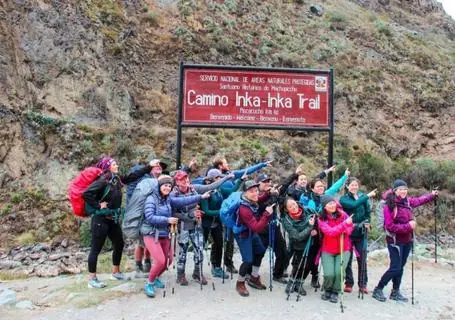
Trek Along the Inca Trail To Machu Picchu
7daysTrek Along The Inca Trail To Machu Picchu with Valencia Travel. We are a renowned Peruvian tour company offering trekking experiences throughout Peru.
card-type-tagAdventure
card-activity-tagModerate - Demanding

Classic Peru Trip
7daysValencia Travel's classic Peru trip is a bucket-list adventure. This 7 Day trip will take you on unforgettable experiences throughout the Peruvian heartland.
card-type-tagCultural, Gastronomy
card-activity-tagEasy

Classic Inca Trail
4daysThe Inca Trail trek to Machu Picchu is the ultimate bucket list hiking experience! Join us on this Classic 4 Day & 3 night Inca Trail Hike!
card-type-tagAdventure
card-activity-tagModerate - Demanding
asso-info-title
asso-info-description
 Aventure
Aventure
 Cultural
Cultural
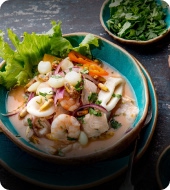 Gastronomy
Gastronomy
 Wellness
Wellness
 Local Living
Local Living
 Luxury
Luxury
















